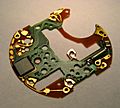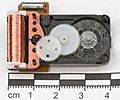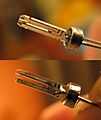Quartz clock facts for kids
A quartz clock is a clock that uses an electronic oscillator that is regulated by a quartz crystal to keep time. This crystal oscillator creates a signal with very precise frequency, so that quartz clocks are at least an order of magnitude more accurate than good mechanical clocks. Generally, some form of digital logic counts the cycles of this signal and provides a numeric time display, usually in units of hours, minutes, and seconds. Since the 1970s, they have become the most widely used timekeeping technology.
Images for kids
-
Circuit board of an e block from a chronograph-wristwatch. Quartz oscillator crystal on right.
-
Disassembeled analog quartz clockwork; real-time clock (RTC) quartz crystal oscillator unit (top left), Lavet-type stepping motor (left) with a black rotor sprocket and connected white and transparent gears (right). These gears control the movement of the second, minute and hour hands.
-
Basic quartz wristwatch movement. Bottom right: quartz crystal oscillator, left: button cell watch battery, top right: oscillator counter, digital frequency divider and driver for the stepping motor (under black epoxy), top left: the coil of the stepper motor that powers the watch hands.
-
Four precision 100 kHz quartz oscillators at the US Bureau of Standards (now NIST) that became the first quartz frequency standard for the United States in 1929. Kept in temperature-controlled ovens to prevent frequency drift due to thermal expansion or contraction of the large quartz resonators (mounted under the glass domes on top of the units) they achieved accuracy of 10−7, roughly 1 second error in 4 months.
See also
 In Spanish: Reloj de cuarzo para niños
In Spanish: Reloj de cuarzo para niños









